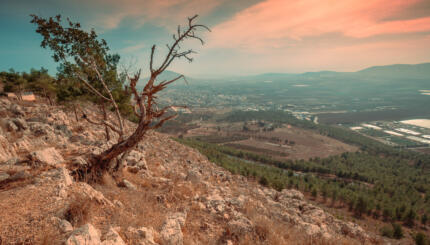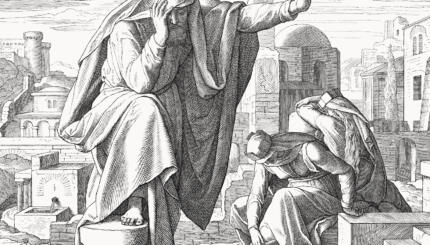Reprinted with permission of The Gale Group from Contemporary Jewish Religious Thought, edited by Arthur A. Cohen and Paul Mendes-Flohr, Twayne Publishers.
In Judaism, memory is a collective mandate, both in terms of what is recalled and how it is recalled. From the Deuteronomic injunctions to “remember the days of old” (32:7) and to “remember what Amalek did to you” (25: 17) to the persistent theme of remembering “that you were sl es in Egypt,” the content of Jewish memory has been the collective saga as first recorded in Scripture and as later recalled in collective, ritual settings.
Central to the meaning of the biblical past is the covenant, Israel’s guarantee that history will follow a divine plan. Thus, the tremors that register most clearly are the breaches of covenant that Israel has been guilty of: “Remember, never forget, how you provoked the Lord your God to anger in the wilderness” (Deuteronomy 9:7). The destructions of the Temple in Jerusalem, the exile from the land, and natural and national catastrophes are all seen as the consequence of God’s retribution for the backslidings of his chosen people.
This theme of guilt, retribution, and exile is most forcefully articulated in the two Tokhehah (literally: reproof) sections of Scripture, Leviticus 26 and Deuteronomy 28, which later generations invariably returned to in times of unprecedented disaster.

Help us keep Jewish knowledge accessible to millions of people around the world.
Your donation to My Jewish Learning fuels endless journeys of Jewish discovery. With your help, My Jewish Learning can continue to provide nonstop opportunities for learning, connection and growth.
After the destruction of Solomon’s Temple (hurban ha-bayit) in 586 B.C.E., the biblical Book of Lamentations and prophetic consolation provided new forms of collective memory. The Book of Lamentations orchestrated a documentary account of Jerusalem’s siege and destruction into individual and choral voices ideally suited for ritual mourning, while the prophets of the exile, notably Ezekiel and Second Isaiah, viewed the exile archetypally, in terms of visionary battles (Gog and Magog), resurrection (the Valley of the Dry Bones), a new Temple, and a new Exodus.
This visionary impulse was carried further by Jewish apocalyptic writers who flourished in Palestine from about 200 B.C.E. to 100 C.E. Through their pseudepigraphic approach, the apocalyptic writers projected a vision of the imminent End of Days as shaped by an esoteric and highly mythic reading of biblical prophecy.
Rabbinic Innovations
With the destruction of Herod’s Temple in 70 C.E. and the subsequent failure of the Bar Kokhba revolt, the rabbis of Jabneh and Usha (the tannaim) triumphed as the sole arbiters of Jewish memory. Most of the apocalyptic writings were excluded from the biblical canon. Even the straightforward chronicles of the Maccabees were consigned to oblivion.
Instead the rabbis proclaimed Scripture as the blueprint of history-past, present, and future. Through public fasts that celebrated God’s historical intervention in nature; through public sermons that sought to link Scripture with the concrete life of the everyday; through the creation of public rituals to commemorate the salvations and destructions of the biblical past, the rabbis were able to canonize, codify, and ritualize historical memory for all generations to come.
The rabbinic approach was to implode history, to cut it down to manageable size. Events were disassembled and reassembled according to biblical archetypes: the Flood, Sodom and Gomorrah, the Akedah (binding of Isaac), the Exodus, Sinai, the breaking of the tablets, the destruction of the Temple, the Exile, the restoration of Zion. The rabbis selected, combined, and arranged events to fit them on a continuum. Thus, the separate destructions of both Temples (in 586 B.C.E. and 70 C.E.) were telescoped together, combined with the capture of Bethar (in 135 C.E.) and the ploughing up of Jerusalem (ca. 130 C.E.), and all four calamities were then linked to the original day of treason in the wilderness; described in Numbers 14 and identified as the ninth day of Av in all cases (Babylonian , Ta’anit. 4:6).
As part of the selection process, the rabbis never treated the individual as worthy of memorialization. There was no place for heroes either in the commemoration of the Exodus on Passover or in the three-week period leading up to the ninth of Av. This collective focus remained in force throughout the Middle Ages, even in Christian Europe, with its plethora of saints’ days. Rabbi Akiva was remembered simply as one of the 10 Harugei Malkhut, the rabbinic martyrs during the Hadrianic persecution. This legendary construct was in turn refashioned sometime in the Byzantine period into a mythic tale with biblical antecedents (the selling of Joseph by his brothers), eventually to become part of the liturgy (in the commemoration of the Ten Martyrs).
Medieval Developments
Indeed, it was liturgy that became the central repository of group memory in the Middle Ages. A number of historical chronicles were written in the wake of the Crusades, and the Expulsion from Spain was the major catalyst for the first serious attempts at postbiblical Jewish historiography, yet both national calamities were commemorated mainly in synagogue ritual: in memorial prayers for the dead, in penitential poems, in additions to the liturgy for the ninth of Av. Fasting and feasting remained the essential ways of recalling local events of special significance such as expulsions, plagues, or deliverance from danger.
Thanks to a system of dating events and of choosing representative places, it was now possible to create new linkages and historical clusters. Thus, the Cossack uprising of 1648-49 was followed by 16 years of foreign invasion, but in Jewish memory, only Tah vetat (1648-1649)–the period of pogroms–was recalled, while the destruction of Nemirov (May 1648) became the stand-in for the ruin of Jewish Poland. The anniversary of Nemirov’s destruction, the 20th of the Hebrew month of Sivan, became a commemorative fast day, linked by date to gezeirat tatkla, the martyrdom of the Jews of Blois in 1171.
As always, it was the subjective reality, not the verifiable facts of destruction, that set the norm and gave rise to new responses. What was remembered and recorded was not the factual data but the meaning of the desecration.
This meaning, in turn, was shaped and expressed by analogies with earlier archetypes. The Hadrianic persecutions had given rise to the archetype of ha-Shem, defined in the Talmud as the public act of sanctifying God’s name in times of persecution (Babylonian Talmud, Sanhedrin 74). Kiddush ha-Shem emerged after the Crusades in combination with two other archetypes. The Akedah and the Temple sacrifice were enlisted by the survivors of the First and Second Crusades in order to view as vicarious atonement the voluntary death of those who had resisted forced conversion.
Similarly, the Marrano experience in 16th-century Spain and Portugal was legitimated in terms of Esther hiding her identity–a pun on Esther-hester (Hebrew for “hiding”)–from King Ahasuerus. With the spread of kabbalah [mysticism] in the 17th century and its enormous impact on Hasidism in the 18th and 19th centuries, the spiritualization of history and the search for archetypal structures were revived just when the modern critical study of history began to take hold among western European Jews.


